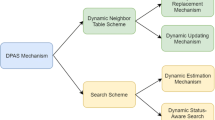Abstract
With the development of the peer-to-peer (P2P) technology, a lot of lookup protocols have come out. Although we can benefit from different protocols separately, our research shows that if there exists a proper model, most of the seemingly different protocols can be classified to a same framework. Since technology is a kind of human behavior, we can set up the P2P lookup general model referring to some outcomes of cognitive psychology. In this paper, we firstly study the lookup model in cognitive psychology, then introduce the model into P2P search strategy, at last we give an improved Chord arithmetic based on the binary tree.
Similar content being viewed by others
References
Stoica, I., Morris, R., Karger, D., Kaashoek, F., Balakrishnan, H.: Chord: A scalable peer-to-peer lookup protocol for Internet applications. IEEE/ACM Trans. Netw. 11(1), 17–32 (2003)
Rowstron, A., Druschel, P.: Pastry: Scalable, decentralized object location and routing for large-scale peer-to-peer systems. In: IFIP/ACM International Conference on Distributed Systems Platforms (Middleware 2001)
Zhao, B.Y., Kubiatowicz, J., Joseph, A.D.: Tapestry: an infrastructure for fault-tolerant wide-area location and routing. Technical Report No. UCB/CSD -01-1141, University of California Berkeley
Ratnasamy, S., Francis, P., Handley, M., Karp, R., Shenker, S.: A scalable content-addressable network. In: Processing of ACMSIGCOMM, 2001, vol. 8, p. 1612172
Ellis, H.C., Hunt, R.R.: Fundamentals of Cognitive Psychology. Brown & Benchmark, Madison (1992)
Solso, R.L., MacLin, M.K., MacLin, O.H.: Cognitive Psychology, 7th edn. Allyn Bacon, Boston (2005)
Duncker, K.: On problem solving. Psychol. Monogr. 58, 270 (1945)
Tryon, R.C.: The genetics of learning ability in rats. Univ. California Publ. Psychol. 4, 71–89 (1929)
Grigorenko, E.L.: The inherent complexities of gene-environment interactions. J. Geront., Ser. B Psychol. Sci. Soc. Sci. 60B(1), 53–64 (2005). Special research on environmental effects in genetic studies of aging
Casto, S.D., DeFries, J.C., Fulker, D.W.: Multivariate genetic analysis of Wechsler intelligence scale for children—revised (WISC–R) factors. Behav. Genet. 25(1), 25–32 (1995)
Devlin, B., Daniels, M., Roeder, K.: The heritability of IQ. Nature 388(6641), 468–471 (1997)
Farroni, T., Massaccesi, S., Pividori, D., Johnson, M.H.: Gaze following in newborns. Infancy 5(1), 39–60 (2004)
Dickens, W.T., Flynn, J.R.: Heritability estimates versus large environmental effects: The IQ paradox resolved. Psychol. Rev. 108, 346–369 (2001)
Johnson, S.: Everything Bad is Good for You: How Today’s Popular Culture is Actually Making us Smarter. Riverhead, New York (2005)
Ceci, S.J.: How much does schooling influence general intelligence and its cognitive components? Dev. Psychol. 27(5), 703–722 (1991)
Bransford, J.D., Stein, B.S.: The IDEAL Problem Solver. Freeman, New York (1984)
Bransford, J.D., Sherwood, R., Vye, N., Rieser, J.: Teaching thinking and problem solving. Am. Psychol. 41(10), 1078–1089 (1986)
Newell, A., Simon, H.A.: Human Problem Solving. Prentice Hall, Englewood Cliffs (1972)
Lovett, M.C., Anderson, J.R.: History of success and current context in problem solving. Cogn. Psychol. 31, 168–217 (1996)
Castro, M., Druschel, P., Hu, Y.C.: Exploiting network proximity in distributed hash tables. In: Proc. IPTPS’02 (2002)
FIPS 180-1. Secure Hash Standard. U.S. Department of Commerce/NIST, National Technical Information Service, Springfield, VA, Apr 1995
Jagadish, H.V., Beng, C.O., Quang, H.V.: BATON: a balanced tree structure for peer-to-peer networks. In: Proceedings of the 31st VLDB Conference, Trondheim, Norway (2005)
Yu, S.-S., Yu, J., Kamil, S.Q.-G.: DR-Chord: an efficient double-ring chord protocol. In: The Sixth International Conference on Grid and Cooperative Computing (GCC 2007), 0-7695-2871-6/07(2007)
Dong, X., Sriram, C., Muralidhar, K.: RChord: an enhanced chord system resilient to routing attacks. In: Proceedings of the 2003 International Conference on Computer Networks and Mobile Computing (ICCNMC’03) 0-7695-2033-2/03 (2003)
He, P., Wang, B.: P-Chord: an partition-based routing model for chord. In: Microelectronics & Computer, 2007. http://www.ilib.cn/A-wdzxyjsj200709022.html. Accessed 1 March 2009
Chen, G., Wu, G., Yang, W.: G-Chord: an improved routing algorithm for Chord, J. Southeast Univ. Nat. Sci. 1 (2007). http://scholar.ilib.cn/A-dndxxb200701003.html. Accessed 1 March 2009
Wang, B.-Q., He, P.: H-Chord: routing model and algorithm implementation for Chord based on hierarchical dividing. Comput. Eng. Appl. 42(36), 141–143 (2007)
Wang, B., He, P.: L-chord: routing model for chord based on layer-dividing. In: 2007 International Conference on Computational Intelligence and Security. doi:10.1109/CIS.2007.62 (2007)
Maymounkov, P., Mazieres, D.: Kademlia: a peer-to-peer information system based on the XOR metric. In: IPTPS 2002
Shouxu, J., Xixian, H., Jianzhong, L.: Improvement of Chord routing algorithm. TP393, 1001-9081(2006)04-
Author information
Authors and Affiliations
Corresponding author
Additional information
This work is financially supported by Program for New Century Excellent Talents in University, No. NCET-08-0738; and National Key project of Scientific and Technical Supporting Programs of China (2008BAH24B04); and the National Key project of Scientific and Technical Supporting Programs of China (2006BAH02A03); and the innovation technology star program of Beijing under grant No. 2007A045.
Rights and permissions
About this article
Cite this article
Ke, X., Meina, S. & Junde, S. An improved P2P lookup protocol model. Cluster Comput 13, 199–211 (2010). https://doi.org/10.1007/s10586-009-0112-0
Received:
Accepted:
Published:
Issue Date:
DOI: https://doi.org/10.1007/s10586-009-0112-0




